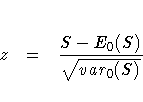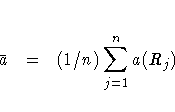Statistics of the form

are called simple linear rank statistics, where
- Rj
- is the rank of the observation j
- a(Rj)
- is the score based on that rank
- cj
- is an indicator variable denoting the class
to which the jth observation belongs
- n
- is the total number of observations
For two-sample data (where the observations are
classified into two levels), PROC NPAR1WAY
calculates simple linear rank statistics for the
scores that you specify. The "Scores for Linear Rank and One-Way ANOVA Tests" section describes
the available scores, which you can use to test
for differences in location and differences in scale.
To compute S, PROC NPAR1WAY sums the scores
of the observations in the smaller of the two samples.
If both samples have the same number of observations,
PROC NPAR1WAY sums those scores for the sample that
appears first in the input data set.
For each score that you specify, PROC NPAR1WAY
computes an asymptotic test of the null hypothesis
of no difference between the two classification
levels. Exact tests are also available for these
two-sample linear rank statistics. PROC NPAR1WAY
computes exact tests for each score type that you
specify in the EXACT statement. See the "Exact Tests" section
for details on exact tests.
To compute an asymptotic test for a linear
rank sum statistic, PROC NPAR1WAY uses a standardized
test statistic z, which has an asymptotic standard
normal distribution under the null hypothesis.
The standardized test statistic is computed as

where E0(S) is the expected value of S under the null
hypothesis, and Var0(S) is the variance under the null
hypothesis. As shown in Randles and Wolfe (1979),

where n1 is the number of observations in the first
(smaller) class level, and
![Var_0(S) =
\frac{1}{(n-1)}
\frac{n_1 \cdot n_2}n
[ \sum_{j=1}^n (a(R_j) - \bar{a} )^2 ]](images/np1eq6.gif)
where

PROC NPAR1WAY computes one-sided and two-sided asymptotic p-values
for each two-sample linear rank test. When the test statistic
z is greater than its null hypothesis expected value of zero,
PROC NPAR1WAY computes the right-sided p-value, which is
the probability of a larger value of the statistic occurring
under the null hypothesis. When the test statistic
is less than or equal to zero, PROC NPAR1WAY computes the
left-sided p-value, which is the probability of a smaller
value of the statistic occurring under the null hypothesis.
The one-sided p-value P1 can be expressed
as


where Z has a standard normal distribution.
The two-sided p-value P2 is computed as

For Wilcoxon scores and Siegel-Tukey scores, PROC NPAR1WAY
incorporates a continuity correction when computing the standardized
test statistic z, unless you specify CORRECT=NO.
PROC NPAR1WAY applies the continuity correction by subtracting
0.5 from the numerator S - E0(S) if it is greater than zero.
If the numerator is less than zero, PROC NPAR1WAY adds 0.5.
Some sources recommend a continuity correction for nonparametric
tests that use a continuous distribution to approximate a discrete
distribution. Refer to Sheskin (1997). If you specify CORRECT=NO,
PROC NPAR1WAY does not use a continuity correction for any test.
Copyright © 1999 by SAS Institute Inc., Cary, NC, USA. All rights reserved.



![Var_0(S) =
\frac{1}{(n-1)}
\frac{n_1 \cdot n_2}n
[ \sum_{j=1}^n (a(R_j) - \bar{a} )^2 ]](images/np1eq6.gif)



